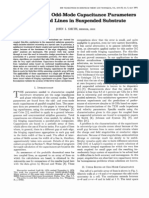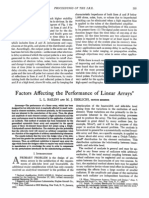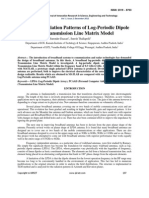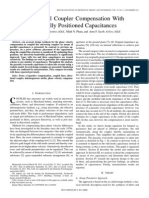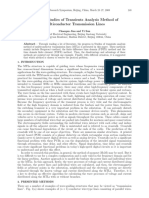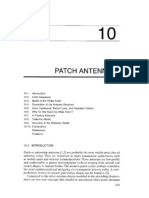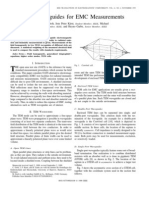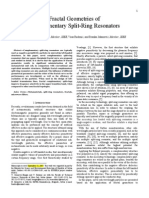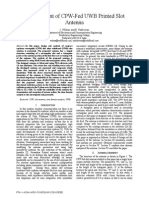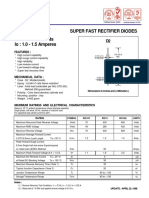On The Convergence of Common FDTD Feed Models For Antennas
On The Convergence of Common FDTD Feed Models For Antennas
Uploaded by
Nag ChallaCopyright:
Available Formats
On The Convergence of Common FDTD Feed Models For Antennas
On The Convergence of Common FDTD Feed Models For Antennas
Uploaded by
Nag ChallaOriginal Title
Copyright
Available Formats
Share this document
Did you find this document useful?
Is this content inappropriate?
Copyright:
Available Formats
On The Convergence of Common FDTD Feed Models For Antennas
On The Convergence of Common FDTD Feed Models For Antennas
Uploaded by
Nag ChallaCopyright:
Available Formats
IEEE TRANSACTIONS ON ANTENNAS AND PROPAGATION, VOL. 51, NO.
8, AUGUST 2003
1771
On the Convergence of Common FDTD Feed Models
for Antennas
Thorsten W. Hertel, Member, IEEE, and Glenn S. Smith, Fellow, IEEE
AbstractThe finite-difference time-domain (FDTD) method
is routinely used to calculate the input admittance/impedance of
simple antennas. The value of the input admittance/impedance
depends on the level of discretization used in the method, and
should converge to a final value as the discretization becomes finer.
In this paper, the level of discretization necessary for convergence
is studied using two common feed models: the hard-source feed
and the transmission-line feed. First, the simplest and most naive
methods for introducing the voltage and the current in these
models are considered, and the results for the admittance are
shown not to converge. Next, improved methods for introducing
the voltage and current in these models are constructed. The
results for the admittance are then shown to converge, and
guidelines are offered for the level of discretization needed for
convergence. In addition, two general problems associated with
the computation of the admittance are discussed: the agreement
between admittances computed with different simple feed models,
and the agreement between these admittances and measurements.
Index TermsConvergence, discretization, finite-difference
time domain (FDTD), hard-source feed, transmission-line feed.
Fig. 1. Model for the linear monopole antenna.
I. INTRODUCTION
HE properties of antennas, such as input impedance and
field patterns, are now routinely determined using the
finite-difference time-domain (FDTD) method for solving
Maxwells equations. When the geometry of the antenna is
accurately represented in the FDTD model, extremely good
agreement can be obtained between the FDTD results and
measurements. As an example, we present results for the
canonical problem shown in Fig. 1: a linear monopole antenna
fed by a coaxial line through an image plane. This is one
of the first antennas accurately analyzed using the FDTD
method [1]. For this example, the ratio of monopole height
, with
5 cm, and the ratio of the
to radius is
with
coaxial line outer radius to inner radius is
1.52 mm. The excitation is at a point in the transmission line
(source plane) where the field is purely transverse electromagnetic (TEM). The rotational symmetry of the antenna and the
excitation allow an analysis in the two spatial coordinates and
. As shown schematically in Fig. 1, the computational domain
Fig. 2. A comparison of the FDTD results with measurements for the input
admittance of the linear monopole.
Manuscript received December 27, 2001; revised May 24, 2002. This work
was supported in part by the John Pippin Chair in Electromagnetics at the
Georgia Institute of Technology.
T. W. Hertel was with the School of Electrical and Computer Engineering,
Georgia Institute of Technology, Atlanta, GA. He is now with Time Domain
Corporation, Cummings Research Park, Huntsville, AL 35806 USA (email:
hertel@ieee.org).
G. S. Smith is with the School of Electrical and Computer Engineering,
Georgia Institute of Technology, Atlanta, GA 30332-0250 USA (email:
glenn.smith@ece.gatech.edu).
Digital Object Identifier 10.1109/TAP.2003.815414
is discretized using rectangular cells with the dimensions
and
.
Fig. 2 is a comparison of theoretical (FDTD) and measured
input admittances [2], [3]. For clarity, the conductance and the
are plotted on a logarithmic
magnitude of the susceptance
scale; the and signs next to the susceptance indicate where
is positive and negative, respectively. Theoretical results are
0018-926X/03$17.00 2003 IEEE
1772
IEEE TRANSACTIONS ON ANTENNAS AND PROPAGATION, VOL. 51, NO. 8, AUGUST 2003
PARAMETERS
FOR THE
TABLE I
DISCRETIZED LINEAR MONOPOLE ANTENNA:
h=a
= 32 9
:
shown for the three levels of discretization given in Table I:
1, 3, and 9 cells,
coarse, medium, and fine, where
respectively. Notice that the other numbers in this table, viz.,
and
, do not scale with
, because a subcell
approach was used to fit an integer number of cells within the
inner and outer radii of the coaxial line. The number of cells per
, at the highest frequency used,
wavelength,
4.5 GHz, is also given in the table. Clearly, the FDTD solution
converges to the measured results with increasing level of discretization over the nearly 300 : 1 range displayed for and
in the figure. Even the medium level of discretization, with
only three cells across the inner radius of the coaxial line, is in
excellent agreement with the measurements.
In the FDTD analysis of an antenna, a simple model is often
used for the feed region of the antenna, i.e., a model that does
not correspond exactly to the geometry of the feed region for
the actual antenna. There are several reasons for using a simple
model, for example, the level of discretization required to accurately model the actual geometry in the feed region may be impractical, then the simple model is used to save computational
resources. Or, the geometry of the actual feed region may be unknown, such as when a balanced antenna is fed by a circuit that
includes a balun, then the simple model is used in an attempt to
separate the analysis of the antenna from that of the balun.
There are two important points we would like to make about
these simple feed models: The first point: The input admittance
of the antenna computed using a simple feed model, in general, will not be in excellent agreement with the measured input
admittance, viz., not in as good agreement as shown in Fig. 2.
This is a result of the geometries of the theoretical and experimental models being different in the feed region. This problem
is not new or unique to numerical methods such as FDTD; it
has been a concern in antenna analysis for at least the last 70
years, and it is discussed in some detail in the treatise by King
[4]. The second point: The admittances computed using two different simple feed models will not necessarily agree precisely
with each other. This is a result of the two simple feed models
not having exactly the same geometry in the feed region. We
will illustrate these two points later in this paper. However, the
objective of this paper is not to rehash these well-known problems. Rather, it is to show, once a simple feed model is adopted,
what steps must be taken to ensure that the results for the input
admittance/impedance converge, and to offer some estimate for
the level of discretization required for convergence.
In Section II of this paper, a brief overview is given of several
simple feed models, and this is followed by a detailed description of the two simple feed models analyzed in this paper: the
(a)
(b)
(c)
(d)
Fig. 3. Feed models for a simple wire antenna: (a) gap feed, (b) frill feed,
(c) monopole transmission-line feed, and (d) infinitesimal-gap feed.
hard-source feed and the transmission-line feed. The remainder
of this paper is concerned with a convergence study for these
two feed models. In Section III, the simple dipole antenna to be
analyzed and the discretizations for the convergence study are
introduced. The results obtained, when the elements of the feed
models are arranged in the simplest and most naive way, are presented in Section IV. Section V describes the critical factors that
must be considered to obtain convergence, presents the results
of the convergence study, and provides guidelines for the discretization necessary for convergence. In Section VI, the results
for the two feed models are compared with measurements and
with each other.
II. AN OVERVIEW OF SIMPLE FDTD FEED MODELS
The purpose of this section is to review previous work on
FDTD feed models. Section II-A gives a brief overview of several feed models, and Section II-B describes in more detail the
two feed models that will be studied in this paper.
A. Background
Several different feed models have been proposed for systems
such as microstrip circuits, printed antennas, and linear wire antennas. A feature many of these models have in common is a
source gap, i.e., the metallic structure of the antenna/circuit is
broken at a point, and a source is placed in the gap. This is illustrated in Fig. 3(a) for the monopole above a ground plane
where the gap is located at the antenna/groundplane interface.
The tangential electric field components within the gap are then
related to an impressed voltage. In the most common configuration, often referred to as the hard-source feed [5][8], these field
HERTEL AND SMITH: ON THE CONVERGENCE OF COMMON FDTD FEED MODELS FOR ANTENNAS
components force the total voltage to follow a time-domain expression, usually a finite-duration signal, e.g., a differentiated
Gaussian pulse in time. When the damping due to radiation is
small, the settling time for the current on the antenna can be
long, and thus require excessively long computer run time for
the hard-source feed. This run time can be reduced significantly
by including a resistance in the source which absorbs energy [9].
In another feed model, the impressed voltage is introduced
in a one-dimensional transmission line that virtually attaches at
the gap in the antenna [10]. This transmission-line feed is especially advantageous for time-domain simulations because the
reflected voltage in the transmission line is obtained directly.
The computer run time for the transmission-line feed is significantly less than that for the hard source, because the resistance
of the matched transmission line absorbs energy.
Despite the popularity of the gap-feed model, these models
have an inherent flaw: the drive-point gap introduces errors in
the susceptance due to its own susceptance [11]. These errors
can be avoided if feed models are implemented that do not physically break the antenna geometry at the drive point. One such
model uses an equivalent frill generator [5], [6]. In this model,
the magnetic or electric fields surrounding the conductor are
used to impress a current on the antenna, see Fig. 3(b).
Other gapless feed models were developed for just thin-wire
antennas in which the contours that are used to update the magnetic field components next to the drive point are slightly modified. In the transmission-line feed for monopole antennas, the
coaxial line, see Section I, is replaced by a simple one-dimensional transmission line [12] that virtually attaches at the antenna/groundplane interface, as shown in Fig. 3(c). Here, the
reflected voltage of the line enters the contour in the segment along the ground plane. A similar hard-source approach
impresses a total voltage in an infinitesimal gap [13]. Here,
the total voltage enters the contour in the segment along the antenna conductor, as shown in Fig. 3(d).
B. Hard-Source and Transmission-Line Feed
Fig. 4 presents schematic drawings for the two feed models to
be analyzed in this paper: Fig. 4(a) is for the hard-source feed,
and Fig. 4(b) is for the transmission-line feed. For both models,
the perfect conductor of the antenna is broken at the drive point
by a gap of width . The electric field in this gap is related to
the terminal voltage between the drive-point terminals by
(1)
In the FDTD method, this integral is converted into a summation that easily can be rewritten to obtain the modified update
equations for the electric field in the gap as a function of the
terminal voltage, e.g.,
(2)
where the gap extends in the direction, as in Fig. 4, and
is the number of cells within the gap, i.e.,
. In both
feed models, the current at the drive point is determined using
1773
(a)
(b)
Fig. 4. Schematic drawings showing (a) the hard-source feed and (b) the
transmission-line feed.
the magnetic field surrounding the conductor of the antenna with
the relation
(3)
The contour is shifted away from the center of the gap in the
direction by the distance , see Fig. 4(a).
In the hard-source feed, Fig. 4(a), the voltage in (1) is the
, and it is specified. The transtotal impressed voltage
mission-line feed, Fig. 4(b), contains a one-dimensional, virtual
transmission line that is attached at the drive-point gap. The variables for this transmission line are the current and the voltage
; as shown in Fig. 5, they are staggered in space and time as
in the conventional FDTD approach. The excitation is produced
by a one-way injector located back in the transmission line at
the source plane [12], [14]. It is referred to as one-way injector,
because the incident signal is launched at the source plane in
only one directiontoward the drive point. This nonphysical
source implementation makes it possible to study the reflected
voltage from the antenna at the observation plane located below
the source plane without the superposition of the incident signal.
is specified in this model. A simple
The incident voltage
absorbing boundary condition is placed at the bottom end of the
transmission line. The coupling of the transmission line to the
antenna is established by updating the electric field in the gap
.
using the last voltage in the line, i.e., (2) with
The voltage coupled to the line is marked with an open dot in
Figs. 4(b) and 5. On the other hand, the coupling of the antenna
1774
IEEE TRANSACTIONS ON ANTENNAS AND PROPAGATION, VOL. 51, NO. 8, AUGUST 2003
(a)
Fig. 5. The one-dimensional transmission line used in the transmission-line
feed.
to the transmission line is established by relating the last current
to the magnetic field near the drive
in the line
point of the antenna using (3).
For the examples to be discussed, the excitation for both
models will be the differentiated Gaussian voltage pulse
(4)
is the characteristic time of the pulse. Note that
for the hard-source feed, and
for the transmission-line feed. This pulse has the advantage
that it has a well-defined spectral peak, and it does not contain
any dc component, which can cause long settling times in the
numerical simulation. Frequency-domain quantities, such as
the input admittance, are obtained using the Fourier transform
of the time-domain results. In the hard-source feed, the input
admittance is determined using the current into the antenna arm,
(3), and the impressed voltage, (4). In the transmission-line
feed, the input admittance is determined using both the incident
and reflected voltages within the transmission line.
(b)
Fig. 6. (a) Model of the linear dipole with square cross section, (b) coarsest
discretization for the model (w= x
, L= x
).
1 =2
PARAMETERS
1 = 77
TABLE II
LINEAR DIPOLE ANTENNA
SECTION
FOR THE DISCRETIZED
SQUARE CROSS
OF
where
III. PROBLEM GEOMETRY AND FDTD DISCRETIZATION
The convergence study is based on the input admittance and
is performed for the perfectly conducting, linear dipole antenna
of length with square cross section of width , shown in
Fig. 6(a). The dipoles length to width ratio is held fixed at
with
10 cm. Notice that the half-length of this
matches the height of the monopole discussed in
dipole
of the square conductor has been set
Section I, and the width
, so that it is approximately equivalent to the round
to
conductor (radius ) of the monopole [15]. This structure is very
easy to discretize with the FDTD method using cubic Yee cells.
For simplicity, at each step in the convergence study, the next
finer discretization is achieved by decreasing the size of the cells
by a factor of two in each direction, i.e., doubling the number of
cells in each direction. Fig. 6(b) shows the coarsest discretization used for the antenna. The dipole has 77 cells along its total
length, 2 cells along its width, and 1 cell across the gap. The
shaded areas in this picture are the faces of the FDTD cells along
which the tangential electric field components are set to zero, so
they delineate the boundaries of the perfectly conducting structure. The excitation is the differentiated Gaussian voltage pulse
and the
(4), with a ratio of characteristic times for the pulse
of
.
antenna
Generally, four different discretizations were used for the
convergence study: coarse, medium, fine, and superfine. Shown
,
in Table II are the number of cells per antenna width
, and the number
the number of cells per antenna length
at the highest frequency
of cells per wavelength
7.0 GHz. The number of cells per wavelength
used,
HERTEL AND SMITH: ON THE CONVERGENCE OF COMMON FDTD FEED MODELS FOR ANTENNAS
1775
(a)
(a)
(b)
(c)
Fig. 7. Basic feeding scheme shown for the first three discretizations.
is often used to determine the numerical dispersion for the
of a wave
method, i.e., the deviation of the phase velocity
in the FDTD grid from the speed of light . A straightforward
at the shortest
analysis was used to determine the ratio
, assuming the wave propagated along only
wavelength
in the three-dimensional grid [16]. These
one direction
results are presented in the last row of the Table II. Notice that
already for the coarsest discretization, with approximately 30
cells per wavelength, there is very little dispersion.
As a point of reference, we note that the rule of thumb often
used for FDTD analysis is that at least 10 cells per shortest wavelength should be used to reduce numerical dispersion to a rea.
sonable level. For this level of discretization,
Of course, numerical dispersion is not the only factor that determines the accuracy of the FDTD computation. In regions where
the details of the local geometry are important, such as at edges
and corners, a much finer discretization may be required to obtain acceptable accuracy. The results presented later will make
this point evident.
(b)
Fig. 8. Input admittance obtained for the dipole with the basic feeding scheme:
(a) hard-source feed and (b) transmission-line feed.
IV. MOTIVATION
In this section, the motivation for this work is described by
presenting results for the admittance when the basic feeding
scheme is employed for both the hard-source feed and the transmission-line feed. The basic feeding scheme is the simplest
and most naive approach for relating and to the electromagnetic field components. The geometry of the feed region
is shown in Fig. 7 for the first three discretizations (coarse,
medium, and fine). Fig. 7(a) is a birds eye view of the feed
region, Fig. 7(b) is a top view, and Fig. 7(c) is a cross-sectional
view. In each discretization, a one-cell gap is employed, i.e.,
the physical length of the gap changes with the discretization,
see Fig. 7(b), while the total length of the antenna remains
the same. Here, just a single electric field in the center of the
Fig. 9. Schematic illustration of the change of the capacitance with varying
length of the gap.
gap is updated with the modified update equation based on
(1). The current is determined by integrating directly around
the drive-point gap, i.e., the contour is not shifted [
in Fig. 4(a)] and has the smallest cross-sectional area; it just
encloses the surface of the conductor, see Fig. 7(c). The magand
that mark the rectangular
netic field components
contour are seen to move closer to the antenna conductor
the finer the discretization. The distance between the surface
1776
IEEE TRANSACTIONS ON ANTENNAS AND PROPAGATION, VOL. 51, NO. 8, AUGUST 2003
(a)
Fig. 10.
(b)
(c)
Improved feeding scheme shown for the first three discretizations.
of the conductor and the magnetic field component is exactly
a half spatial step of the corresponding grid.
) from this study
The results for the input admittance ( ,
are shown in Fig. 8 for the first three discretizations. Fig. 8(a) is
for the hard-source feed and Fig. 8(b) is for the transmission-line
feed. Again, the admittance is shown on a logarithmic scale for
clarity. The results appear to converge with finer discretization
at the lower frequencies, but they clearly do not converge at the
higher frequencies.
V. IMPROVED FEEDING SCHEME AND DISCRETIZATION
NECESSARY FOR CONVERGENCE
To obtain convergence, it is crucial to properly position and
scale the elements in the feed model. Fig. 9 illustrates how different geometrical lengths of the gap introduce a change in the
susceptance. As shown schematically, the decrease in length increases the capacitance at the drive point. To avoid this source
of error, the length of the drive point-gap must be the same for
each discretization.
The above criteria are met in the improved feeding scheme.
Schematic drawings of the drive-point region for this scheme
are shown in Fig. 10. Here, the drive-point gap properly scales
for each discretization by keeping the length of the gap constant
. For discretizations finer than the coarsest one, this
at
requires a multiple-cell gap, see Fig. 10(b). In order to apply the
voltage in the gap uniformly, all tangential electric field components within the gap are updated based on (1). The current
to avoid the
contour in this new model is shifted to
fringing of the electric field in the gap.1 Furthermore, the contour is chosen to be the same for every discretization. Notice
that in order to properly scale and position the current contour,
1The motivation of an offset contour [s > l =2 in Fig. 4(a)] is to enclose the
total current into the antenna conductor, i.e., the conduction current, instead of
a portion of the displacement current that is obtained when the contour encloses
the gap.
Fig. 11.
Proper scaling of the reference planes in the transmission line.
averages in the transverse and longitudinal directions are necessary for the discretizations finer than the coarsest one. This
can clearly be seen in the schematic drawings in Fig. 10(b) (top
view) and in Fig. 10(c) (cross-sectional view).
For the transmission-line model, it is crucial to properly position the reference planes for the voltages and currents in the
transmission line. In the present approach, the reference plane
for the current in the last cell is chosen to be the same for all
discretizations.2 This plane is shown as a solid line in Fig. 11.
The reference plane for the voltage that couples the line to the
antenna must be placed at the same location for all discretizations.3 This plane is set by the position of the voltage in the last
cell of the coarsest grid and is shown as a dashed line in Fig. 11.
Notice that for discretizations finer than the coarsest one, averages are necessary to determine the corresponding voltage at
this plane.
The input admittance is shown as a function of frequency in
Fig. 12 for the first three discretizations. The results are seen
to converge for the hard-source feed in Fig. 12(a) and for the
transmission-line feed in Fig. 12(b). To better examine the convergence of the results, the admittances are shown for the improved feeding scheme in Fig. 13 over the limited frequency
2Recall that I (l
) couples the antenna in the three-dimensional FDTD grid
to the one-dimensional transmission line.
3Recall that in the basic feeding scheme, V (l
) is used for the coupling.
HERTEL AND SMITH: ON THE CONVERGENCE OF COMMON FDTD FEED MODELS FOR ANTENNAS
1777
(a)
Fig. 13.
scheme.
Comparison of the results for the admittance: improved feeding
TABLE III
FREQUENCY AND CONDUCTANCE AT ANTIRESONANCE FOR THE HARD SOURCE:
(TOP) BASIC FEEDING SCHEME: (BOTTOM) THE IMPROVED FEEDING SCHEME
(b)
Fig. 12. Input admittance obtained for the dipole with the improved feeding
scheme: (a) hard-source and (b) transmission-line feeds.
range 3.9 GHz
4.1 GHz. Clearly, the results for the
and the susceptance
converge for both the
conductance
hard-source and transmission-line feed.
To analyze the results for convergence quantitatively, the
and the conductance
at antiresonance
frequency
, or
(the point where is zero for the second time,
) are given for the hard-source feed in
equivalently
and
are seen not to converge for the
Table III. Clearly,
basic feeding scheme in Table III (top); whereas, they converge
for the improved feeding scheme in Table III (bottom). Notice
that the number of cells required for convergence is fairly large:
Even for the coarse discretization, with about 100 cells per
wavelength, the conductance at antiresonance differs from the
final value (superfine discretization) by about 3%. Thus, we
see that the rule of thumb of 10 cells per wavelength needed
to control numerical dispersion is rather meaningless for this
example. A much finer discretization is needed to model the
details in the feed region of this antenna and to determine an
accurate value for the input admittance.
VI. DISCUSSION
To complete our discussion, we will return to the two points
made in the Introduction to the paper: The first point is that
the input admittance of the antenna computed using a simple
feed model, in general, will not be in very good agreement with
the measured input admittance. And the second point is that the
admittances computed using two different simple feed models
will not necessarily agree with each other.
In Fig. 14, we compare the input admittances for the dipole
antenna computed using the two simple feed models (hardsource and transmission-line feeds) with the measured results
for the monopole antenna described in Section I. The measured
results for the monopole shown in Fig. 2 have been divided
by a factor of two for this comparison. Both of the computed
1778
IEEE TRANSACTIONS ON ANTENNAS AND PROPAGATION, VOL. 51, NO. 8, AUGUST 2003
(a)
Fig. 14. Comparison of the numerical results for the input admittance with the
measurement.
results are for the fine discretization, so, as shown in Fig. 12,
the admittances have converged. The two theoretical results for
the input conductance are in very good agreement with the
measurements. However, neither of the computed results for
is in very good agreement with the
the input susceptance
measurements, although the results for the transmission-line
feed are significantly closer to the measurements than those
for the hard-source feed. Clearly, to obtain excellent agreement
between theory and experiment, as demonstrated in Fig. 2, all
of the details of the experimental model must be included in
the theoretical model.
In Fig. 14, the two theoretical results for the input susceptance
are significantly different. This difference is caused by the
differences in the geometry in the drive-point region for the two
theoretical models. When the two susceptances are subtracted
, the
and a capacitance computed, i.e.,
result shown in Fig. 15(a) is obtained. Notice that the capacitance is approximately 0.04 pF over the range of frequencies
of interest. As shown in Fig. 15(b), when this capacitance is
added to the admittance calculated with the hard-source feed,
it is in excellent agreement with the admittance calculated with
the transmission-line feed. So the difference in the two simple
feed models can be attributed to a local capacitance at the drive
point. Clearly, to obtain excellent agreement between results for
two theoretical models, all of the details for the two models, such
as those in the feed region, must be the same.
in Fig. 14, one
From the results for the susceptance
might conclude that the transmission-line feed is a better model
than the hard-source feed because it is in better agreement with
the measurements. However, this conclusion would not be true.
The susceptance for the hard-source feed can be put into better
agreement with the measurements by adjusting the size of the
gap and the position of the contour. This points out a weakness
of simple feed models. They have free parameters, and there are
no unique values for these parameters that will produce equally
good agreement with measurements for a variety of antennas.
(b)
Fig. 15. (a) Plot of the additional local capacitance at the drive point.
(b) Comparison of the input susceptance for the transmission-line feed and
the hard-source feed when the capacitance C
0.04 pF is added in the
hard-source feed.
VII. CONCLUSION
Two antenna feed models (hard-source and transmission-line
feeds) commonly used in the FDTD method were shown to converge only when the elements of the feed are properly scaled
and positioned. These elements are the length of the drive-point
gap and the size and position of the current contour. For the
transmission-line feed, this also includes the proper positioning
of the reference plane for the voltage in the transmission line
that couples the line to the antenna. The discretization necessary
for convergence was shown to be much finer than one typically
expects.
REFERENCES
[1] J. G. Maloney, G. S. Smith, and W. R. Scott Jr., Accurate computation of the radiation from simple antennas using the finite-difference
time-domain method, IEEE Trans. Antennas Propagat., vol. 38, pp.
10591068, July 1990.
HERTEL AND SMITH: ON THE CONVERGENCE OF COMMON FDTD FEED MODELS FOR ANTENNAS
[2] W. R. Scott Jr., Dielectric spectroscopy using shielded open-circuited
coaxial lines and monopole antennas of general length, Ph.D. dissertation, Georgia Inst. Technol., Atlanta, GA, 1985.
[3] T. W. Hertel and G. S. Smith, The insulated linear antennarevisited,
IEEE Trans. Antennas Propagat., vol. 48, pp. 914920, June 2000.
[4] R. W. P. King, The Theory of Linear Antennas. Cambridge, MA: Harvard Univ. Press, 1956.
[5] R. Luebbers, L. Chen, T. Uno, and S. Adachi, FDTD calculation of radiation patterns, impedance, and gain for a monopole antenna on a conducting box, IEEE Trans. Antennas Propagat., vol. 40, pp. 15771583,
Dec. 1992.
[6] P. A. Tirkas and C. A. Balanis, Finite-difference time-domain method
for antenna radiation, IEEE Trans. Antennas Propagat., vol. 40, pp.
334340, Mar. 1992.
[7] M. R. Zunoubi, N. H. Younan, J. H. Beggs, and C. D. Taylor, FDTD
analysis of linear antennas driven from a discrete impulse excitation,
IEEE Trans. Electromagn. Compat., vol. 39, pp. 247250, Aug. 1997.
[8] C. E. Brench and O. M. Ramahi, Source selection criteria for FDTD
models, in Proc. IEEE Electromagnetic Compatibility Symp., vol. 1,
1998, pp. 491494.
[9] R. J. Luebbers and H. S. Langdon, A simple feed model that reduces
time steps needed for FDTD antenna and microstrip calculations, IEEE
Trans. Antennas Propagat., vol. 44, pp. 10001005, July 1996.
[10] J. M. Bourgeois and G. S. Smith, A fully three-dimensional simulation of a ground-penetrating radar: FDTD theory compared with experiment, IEEE Trans. Geosci. Remote Sensing, vol. 34, pp. 3644, Jan.
1996.
[11] E. Semouchkina, W. Cao, and R. Mittra, Source excitation methods
for the finite-difference time-domain modeling of circuits and devices,
Microwave Opt. Technol. Lett., vol. 21, pp. 93100, 1999.
[12] J. G. Maloney, K. L. Shlager, and G. S. Smith, A simple FDTD model
for transient excitation of antennas by transmission lines, IEEE Trans.
Antennas Propagat., vol. 42, pp. 289292, Feb. 1994.
[13] S. Watanabe and M. Taki, An improved FDTD model for the feeding
gap of a thin-wire antenna, IEEE Microwave Guided Wave Lett., vol.
8, pp. 152154, Apr. 1998.
[14] J. G. Maloney and G. S. Smith, Modeling of antennas, in Advances
in Computational Electrodynamics: The Finite-Difference Time-Domain
Method, A. Taflove, Ed. Norwood, MA: Artech House, 1998.
[15] C. A. Balanis, Antenna Theory Analysis and Design. New York: Wiley,
1997.
[16] A. Taflove, Computational Electrodynamics: The Finite-Difference
Time-Domain Method. Norwood, MA: Artech House, 2000.
1779
Thorsten W. Hertel (S96M02) was born in Holzminden, Germany, on April 19, 1974. He received
the Vordiplom degree in electrical engineering
from the Technische Universitt Braunschweig,
Braunschweig, Germany, in 1995, and the M.S.
and Ph.D. degrees from the Georgia Institute of
Technology (Georgia Tech), Atlanta, in 1998 and
2001, respectively, both in electrical and computer
engineering.
In 2002, for six months, he continued to work at
Georgia Tech as Postdoctoral Fellow, working on
pulsed and broad-band antennas. Since July of 2002, he has been an Antenna
Design Engineer with Time Domain Corporation, Huntsville, AL, working on
ultra-wide-band antennas. His special interests include numerical modeling
with the finite-difference time-domain (FDTD) method and antenna analysis.
Glenn S. Smith (S65M72SM80F86) received
the B.S.E.E. degree from Tufts University, Medford,
MA, in 1967 and the S.M. and Ph.D. degrees in applied physics from Harvard University, Cambridge,
MA, in 1968 and 1972, respectively.
From 1972 to 1975, he served as a Postdoctoral
Research Fellow at Harvard University and also as a
part-time Research Associate and Instructor at Northeastern University, Boston, MA. In 1975, he joined
the faculty of the School of Electrical and Computer
Engineering at the Georgia Institute of Technology,
Atlanta, where he is currently Regents Professor and John Pippin Chair in Electromagnetics. His technical interests include: basic electromagnetic theory and
measurements, antennas and wave propagation in materials, and the radiation
and reception of pulses by antennas. He is the author of the book An Introduction to Classical Electromagnetic Radiation (Cambridge Univ. Press, 1997) and
coauthor of the book Antennas in Matter: Fundamentals, Theory and Applications (MIT Press, 1981). He also authored the chapter Loop Antennas in the
McGraw-Hill Antenna Engineering Handbook, 1993.
Prof. Smith is a Member of Tau Beta Pi, Eta Kappa Nu, and Sigma Xi and a
member of URSI Commissions A and B.
You might also like
- Sample Arc Flash Study ReportDocument101 pagesSample Arc Flash Study ReportRitaban222100% (9)
- M1-MCI360 Compartment Batcher Maintenance ManualDocument226 pagesM1-MCI360 Compartment Batcher Maintenance ManualNeetan Singla95% (129)
- Distribution Safety Rules 2016Document118 pagesDistribution Safety Rules 2016bxteo0% (1)
- FAG InsutectDocument2 pagesFAG InsutectVIKAS BHANDARE100% (1)
- Characterization of Conducted EMI Generated by Switched Power ConvertersDocument3 pagesCharacterization of Conducted EMI Generated by Switched Power ConvertersskrtamilNo ratings yet
- TX-RX Isolation Exploiting Tunable Balanced - Unbalanced Antennas ArchitectureDocument4 pagesTX-RX Isolation Exploiting Tunable Balanced - Unbalanced Antennas ArchitecturepathmakerpkNo ratings yet
- Simple Model For Computing The Input Impedance of A Rectangular Patch Antenna With Electromagnetic CouplingDocument5 pagesSimple Model For Computing The Input Impedance of A Rectangular Patch Antenna With Electromagnetic CouplingSachin PalNo ratings yet
- Abstract:: RatioDocument18 pagesAbstract:: RatioNaveen ChaubeyNo ratings yet
- The Even - and Odd-Mode Capacitance Parameters For Coupled Lines in Suspended SubstrateDocument8 pagesThe Even - and Odd-Mode Capacitance Parameters For Coupled Lines in Suspended SubstrateSam SomarithNo ratings yet
- Ref62 Bailin - Hughes.1952Document7 pagesRef62 Bailin - Hughes.1952aveliveloNo ratings yet
- GARFIELD, Recent DevtsDocument5 pagesGARFIELD, Recent DevtsHope Earl Ropia BoronganNo ratings yet
- Analysis of Radiation Patterns of Log-Periodic Dipole Array Using Transmission Line Matrix ModelDocument9 pagesAnalysis of Radiation Patterns of Log-Periodic Dipole Array Using Transmission Line Matrix ModelQuoc Nguyen100% (1)
- A High Frequency Equivalent Circuit and Parameter Extraction Procedure For Common Mode Choke in The EMI FilterDocument10 pagesA High Frequency Equivalent Circuit and Parameter Extraction Procedure For Common Mode Choke in The EMI FilterYea Ji HanNo ratings yet
- VFT Study For EHV-GIS Substation: Amit Kumar and Mahesh K. MishraDocument6 pagesVFT Study For EHV-GIS Substation: Amit Kumar and Mahesh K. Mishraarunw110No ratings yet
- A Compact Dipole Antenna For DTV Applications by Utilizing L-Shaped Stub and Coupling StripDocument6 pagesA Compact Dipole Antenna For DTV Applications by Utilizing L-Shaped Stub and Coupling StripWidyana ParamitaNo ratings yet
- Chapter 3. Example of A Visualization TechniqueDocument21 pagesChapter 3. Example of A Visualization TechniqueMujeeb AbdullahNo ratings yet
- Analytical Calculation of Leakage Inductance For Low-Frequency Transformer ModelingDocument9 pagesAnalytical Calculation of Leakage Inductance For Low-Frequency Transformer ModelingLiola LailaNo ratings yet
- Progress in Electromagnetics Research Letters, Vol. 39, 103-113, 2013Document11 pagesProgress in Electromagnetics Research Letters, Vol. 39, 103-113, 2013iccwcsNo ratings yet
- Stacked Printed Antennas Array For C Band ApplicationsDocument12 pagesStacked Printed Antennas Array For C Band ApplicationsijdpsNo ratings yet
- Y J C M J: 41. The Microstrip Antennas Were Miniaturised byDocument4 pagesY J C M J: 41. The Microstrip Antennas Were Miniaturised bynounouNo ratings yet
- Vftos in GISDocument5 pagesVftos in GISdeepak_27No ratings yet
- A Circuit-Theoretic ApproachDocument5 pagesA Circuit-Theoretic Approachesra8No ratings yet
- Stacked Annular Ring Dielectric Resonator Antenna Excited by Axi-Symmetric Coaxial ProbeDocument4 pagesStacked Annular Ring Dielectric Resonator Antenna Excited by Axi-Symmetric Coaxial ProbeJatin GaurNo ratings yet
- NLTL Emc FDQDocument4 pagesNLTL Emc FDQBOUZIANE AmineNo ratings yet
- 1 5Document35 pages1 5manasa324No ratings yet
- A Link Between EMTP RV and Flux3D For Transformer Energization StudiesDocument6 pagesA Link Between EMTP RV and Flux3D For Transformer Energization StudiesleivajNo ratings yet
- A Novel Method For Ultra-HighFrequency PD Loc in Power TF Using Particle Swarm Opt AlgoDocument14 pagesA Novel Method For Ultra-HighFrequency PD Loc in Power TF Using Particle Swarm Opt AlgoSwathiMuthyalaRamesh100% (1)
- Transformer Joints FE Analysis Using Pseudo-Source TechniqueDocument4 pagesTransformer Joints FE Analysis Using Pseudo-Source TechniqueRavi RajNo ratings yet
- Microwave Planar Antenna DesignDocument57 pagesMicrowave Planar Antenna DesignMohamed Hussien HamedNo ratings yet
- Design of A Dual Monopole Antenna With Wideband Frequency: Progress in Electromagnetics Research C, Vol. 3, 119-128, 2008Document10 pagesDesign of A Dual Monopole Antenna With Wideband Frequency: Progress in Electromagnetics Research C, Vol. 3, 119-128, 2008darealboyNo ratings yet
- DC4 PDFDocument9 pagesDC4 PDFShrutiAwasthiNo ratings yet
- A Systematic Approach To Electromagnetic Compatibility Analysis and Design in Utility SystemsDocument8 pagesA Systematic Approach To Electromagnetic Compatibility Analysis and Design in Utility SystemsboopelectraNo ratings yet
- Experimental Mode Content Analysis For Coplex Overmoded Waveguire Systems - Cepni Et AlDocument4 pagesExperimental Mode Content Analysis For Coplex Overmoded Waveguire Systems - Cepni Et AldpshepherdNo ratings yet
- (Ij TX: Approximnately 0018-9510/85/0002-0366$01.00©Document7 pages(Ij TX: Approximnately 0018-9510/85/0002-0366$01.00©Muhammed Cihat AltınNo ratings yet
- Skin Effect and Dielectric Loss Models of Power Cables 04784562Document8 pagesSkin Effect and Dielectric Loss Models of Power Cables 04784562Gilberto Mejía100% (1)
- High Frequency Transformers For DC-DC ConvertersDocument6 pagesHigh Frequency Transformers For DC-DC ConvertersÄlî VàráNo ratings yet
- Fast Prediction of Transmission Line Radiated Emissions Using The Hertzian Dipole Method and Line-End Discontinuity ModelsDocument9 pagesFast Prediction of Transmission Line Radiated Emissions Using The Hertzian Dipole Method and Line-End Discontinuity ModelsJuanNo ratings yet
- Microstrip AntennaDocument5 pagesMicrostrip AntennaTDMA2009No ratings yet
- Progress in Studies of Transients Analysis Method of Multiconductor Transmission LinesDocument5 pagesProgress in Studies of Transients Analysis Method of Multiconductor Transmission LinesKushtrim MalaNo ratings yet
- Electromagnetic Interference Modeling Research On The Electrical Machine and Converter SystemsDocument4 pagesElectromagnetic Interference Modeling Research On The Electrical Machine and Converter SystemsjaynepalNo ratings yet
- HelicalDocument8 pagesHelicalAnamiya BhattacharyaNo ratings yet
- Accuracy and Realization Issues in FrequencyDocument7 pagesAccuracy and Realization Issues in FrequencyEleazar Sierra EspinozaNo ratings yet
- EEE Power Delivery, Vol. 10, No. 2, April: Combined Application of Charge Simulation andDocument7 pagesEEE Power Delivery, Vol. 10, No. 2, April: Combined Application of Charge Simulation andPika TrollNo ratings yet
- FDTD Model Performance Analysis For A Cavity Slot Antenna Array in A Variable Geometry Conformal Test RigDocument2 pagesFDTD Model Performance Analysis For A Cavity Slot Antenna Array in A Variable Geometry Conformal Test RigTimothy PelhamNo ratings yet
- 03 Yaralioglu 02 PDFDocument4 pages03 Yaralioglu 02 PDFCesar ManNo ratings yet
- Fast Finite Difference Time DomainDocument5 pagesFast Finite Difference Time Domainothmanem449No ratings yet
- Modelling of OHL and UG PDFDocument6 pagesModelling of OHL and UG PDFCarlos Lino Rojas AgüeroNo ratings yet
- Analysis of A Full E-Shaped AntennaDocument4 pagesAnalysis of A Full E-Shaped AntennaIvanNo ratings yet
- Antenna and EM Modeling With MATLABDocument21 pagesAntenna and EM Modeling With MATLABNatasha SearsNo ratings yet
- Band Stop Filter TodayDocument4 pagesBand Stop Filter TodayrehanNo ratings yet
- The Is: ShortDocument4 pagesThe Is: ShortDr-Ahmed ElkoranyNo ratings yet
- 108 MohanDocument10 pages108 MohanRECEP BAŞNo ratings yet
- This: Study and Design Compact Wideband Microstrip AntennasDocument4 pagesThis: Study and Design Compact Wideband Microstrip Antennasalokcena007No ratings yet
- Capacity and Power Allocation For Fading MIMO Channels With Channel Estimation ErrorDocument12 pagesCapacity and Power Allocation For Fading MIMO Channels With Channel Estimation ErrorNadeem PashaNo ratings yet
- Equivalent CKTDocument10 pagesEquivalent CKTvinothramadosNo ratings yet
- 3 - (2002) Thin Wire Representation in Finite Difference Time Domain Surge SimulationDocument8 pages3 - (2002) Thin Wire Representation in Finite Difference Time Domain Surge SimulationGuiNo ratings yet
- Crosstalk - Correção Por ComprimentoDocument9 pagesCrosstalk - Correção Por ComprimentoPaulo FiscinaNo ratings yet
- Ok - (1983) - Transient Analysis of Grounding Systems - MeliopoulosDocument11 pagesOk - (1983) - Transient Analysis of Grounding Systems - MeliopoulosTiago Amanda DiasNo ratings yet
- HN33S33Document6 pagesHN33S33Rohit MittalNo ratings yet
- Variação Dos Parâmetros Do Cabo Pelo Efeito Pelicular e Proximidade Utilizando Elementos Finitos - André Cirino (2009)Document7 pagesVariação Dos Parâmetros Do Cabo Pelo Efeito Pelicular e Proximidade Utilizando Elementos Finitos - André Cirino (2009)AndréNo ratings yet
- Broadband Analysis of Microstrip Patch Antenna Using 3D FDTD - UPMLDocument30 pagesBroadband Analysis of Microstrip Patch Antenna Using 3D FDTD - UPMLBel AbdNo ratings yet
- TEM Wave Guides For EMC MeasurementsDocument6 pagesTEM Wave Guides For EMC MeasurementsGuanghua LiNo ratings yet
- Power Measurements Under Nonsinusoidal Conditions : A Thesis in Electrical EngineeringFrom EverandPower Measurements Under Nonsinusoidal Conditions : A Thesis in Electrical EngineeringNo ratings yet
- CPW-Fed Capacitive Coupled Slot Antenna: Nternational Ournal of Nnovative Esearch in Omputer and Ommunication NgineeringDocument6 pagesCPW-Fed Capacitive Coupled Slot Antenna: Nternational Ournal of Nnovative Esearch in Omputer and Ommunication NgineeringNag ChallaNo ratings yet
- LNEE Paper TemplateDocument7 pagesLNEE Paper TemplateNag ChallaNo ratings yet
- A Note On The Impedance Variation With Feed Position of A Rectangular Microstrip-Patch AntennaDocument3 pagesA Note On The Impedance Variation With Feed Position of A Rectangular Microstrip-Patch AntennaNag ChallaNo ratings yet
- Emig (Na cm91gDocument4 pagesEmig (Na cm91gNag ChallaNo ratings yet
- Massachusetts Banking: Inset Fed Patch Antenna Simulation and ResultDocument18 pagesMassachusetts Banking: Inset Fed Patch Antenna Simulation and ResultNag ChallaNo ratings yet
- Matlab Graphics: Line Width: Notes: Using Linewidth You Can Control The Width of Plotted Lines. Example ScriptDocument1 pageMatlab Graphics: Line Width: Notes: Using Linewidth You Can Control The Width of Plotted Lines. Example ScriptNag ChallaNo ratings yet
- MTT October 2008Document11 pagesMTT October 2008Nag ChallaNo ratings yet
- 5.8Ghz Circularly Polarized Rectennas Using Schottky Diode and Ltc5535 Rectifier For RF Energy HarvestingDocument4 pages5.8Ghz Circularly Polarized Rectennas Using Schottky Diode and Ltc5535 Rectifier For RF Energy HarvestingNag ChallaNo ratings yet
- Circularly Polarised Equilateral-Triangular Microstrip Antenna With Truncated TipDocument2 pagesCircularly Polarised Equilateral-Triangular Microstrip Antenna With Truncated TipNag ChallaNo ratings yet
- Design Consideration of Microstrip Patch AntennaDocument11 pagesDesign Consideration of Microstrip Patch AntennaNag ChallaNo ratings yet
- Introduction To Antenna Types and Their Applications: Abstract This Paper Introduces Antenna Theory and DiscussesDocument7 pagesIntroduction To Antenna Types and Their Applications: Abstract This Paper Introduces Antenna Theory and DiscussesNag ChallaNo ratings yet
- Implantable CPW Fed Slot Monopole Antenna For Biomedical ApplicationsDocument4 pagesImplantable CPW Fed Slot Monopole Antenna For Biomedical ApplicationsNag ChallaNo ratings yet
- Development of CPW-Fed UWB Printed Slot Antenna: J. William and R. NakkeeranDocument5 pagesDevelopment of CPW-Fed UWB Printed Slot Antenna: J. William and R. NakkeeranNag ChallaNo ratings yet
- Pankaj EMT AssignDocument6 pagesPankaj EMT AssignpankajmadhuNo ratings yet
- Sgt50t65fd1pn (p7) (PS) (PT) DatasheetDocument11 pagesSgt50t65fd1pn (p7) (PS) (PT) DatasheetRui BoanovaNo ratings yet
- Welding Procedure For BOXNR Wagon (WPS)Document8 pagesWelding Procedure For BOXNR Wagon (WPS)Shekher NikhilNo ratings yet
- Catalogue-Simoprime en PDFDocument16 pagesCatalogue-Simoprime en PDFhizbi7No ratings yet
- Nuhas Oman - Cables & WiresDocument76 pagesNuhas Oman - Cables & WiresNuhasNo ratings yet
- 3vt MCCB CatalogueDocument270 pages3vt MCCB Cataloguerocket-vtNo ratings yet
- Product Sheet: Nibp100D Noninvasive Blood Pressure Monitoring SystemDocument3 pagesProduct Sheet: Nibp100D Noninvasive Blood Pressure Monitoring SystemSadegh ShebaniNo ratings yet
- 12 TeupenDocument28 pages12 TeupenJarek FedkoNo ratings yet
- Skyworks High-Power SwitchesDocument4 pagesSkyworks High-Power Switchesmymobilej71402No ratings yet
- A.C. Static Watthour Meters, Class 1 and 2 - Specification: Indian StandardDocument38 pagesA.C. Static Watthour Meters, Class 1 and 2 - Specification: Indian StandardKartikeya SharmaNo ratings yet
- P. 33kv Line MaterialsDocument7 pagesP. 33kv Line MaterialsUttam Kumar Halder100% (1)
- Klonulator v1.0Document18 pagesKlonulator v1.0ultratumbaNo ratings yet
- RG10 - RG10Y: Super Fast Rectifier Diodes PRV: 70 - 600 Volts Io: 1.0 - 1.5 AmperesDocument3 pagesRG10 - RG10Y: Super Fast Rectifier Diodes PRV: 70 - 600 Volts Io: 1.0 - 1.5 Amperesantony vargasNo ratings yet
- Bizarre EMI IncidentsDocument61 pagesBizarre EMI IncidentsJagbir SinghNo ratings yet
- BA200 ISE Module MaintenanceDocument4 pagesBA200 ISE Module MaintenanceRoger RogelioNo ratings yet
- BJT Mosfet IgbtDocument26 pagesBJT Mosfet IgbtSubhash MurkuteNo ratings yet
- L C R Circuit Series and Parallel1Document6 pagesL C R Circuit Series and Parallel1krishcvrNo ratings yet
- SATUANDocument1 pageSATUANagungcsyNo ratings yet
- Ferrite Cores: ZR, ZRH, ZRS, ZRSH Series For High Frequency Welding Impeder CoresDocument13 pagesFerrite Cores: ZR, ZRH, ZRS, ZRSH Series For High Frequency Welding Impeder CoresАлексей АндрияшNo ratings yet
- AS CDLamb A18Document23 pagesAS CDLamb A18Anderson PinzónNo ratings yet
- Banner U GAGE QT50U Series SensorsDocument36 pagesBanner U GAGE QT50U Series SensorsMemik TylnNo ratings yet
- Programme(s) Semester Course Code (S) Course Title BE 03 17MT305 Theory of Control Systems Course OutcomesDocument7 pagesProgramme(s) Semester Course Code (S) Course Title BE 03 17MT305 Theory of Control Systems Course OutcomeskesavantNo ratings yet
- Power Factor Correction & PFC ConvertersDocument19 pagesPower Factor Correction & PFC ConvertersSandeep Guha Niyogi100% (1)
- Szabmu-Physics-Most Repeated Mcqs Series 2024Document88 pagesSzabmu-Physics-Most Repeated Mcqs Series 2024gulfam.tamesideNo ratings yet
- Review Article: A Review On The Efficiency of Graphene-Based BHJ Organic Solar CellsDocument16 pagesReview Article: A Review On The Efficiency of Graphene-Based BHJ Organic Solar CellsJohn Lloyd GenerosoNo ratings yet
- Wei - Links - Chapter02 Energy-Efficient Design of High-Speed LinksDocument39 pagesWei - Links - Chapter02 Energy-Efficient Design of High-Speed LinksDaniel WeinfeldNo ratings yet








